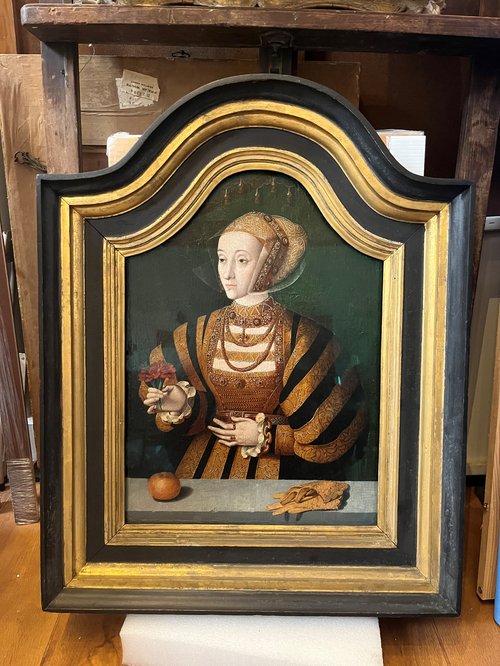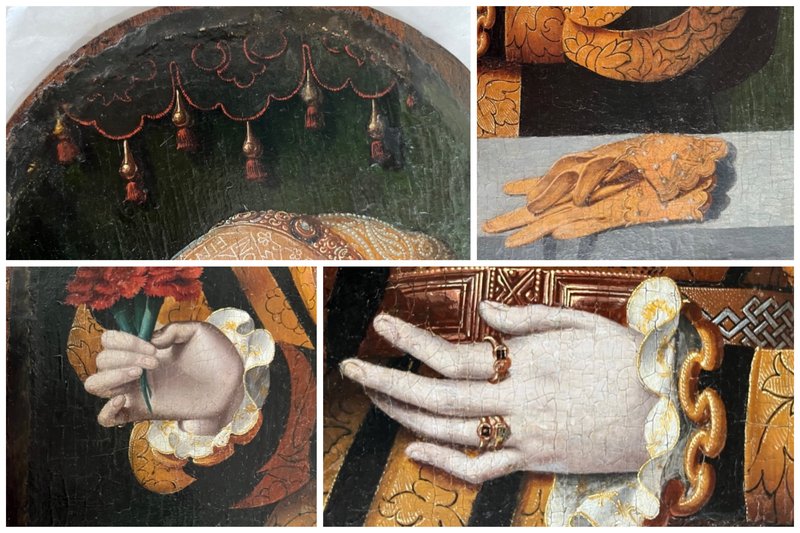Anne of Cleves at the National Portrait Gallery
From 20 June until 8 September, the portrait of Anne of Cleves usually ascribed to Bartholomaeus Bruyn the Elder in the College collection stars in the major exhibition at the National Portrait Gallery, Six Lives: The Stories of Henry VIII’s Queens. It will be the first time in nearly two centuries that it will be shown in its original frame, following a discovery by the frame historian and conservator Timothy Newbery, which provides additional confirmation for the 16th-century date of the painting and its possible identity as one of the portraits famously shown to Henry VIII’s ambassadors during the marriage negotiations.

The portrait was purchased in c.1734 by the then President and major benefactor of St John’s, William Holmes, for his private collection, and then acquired for the College by his successor as President, William Derham, in 1748. The sitter was only identified in print as Anne of Cleves as late as 1855, in J. W. Burgon’s Arms of the Colleges of Oxford. The date and authorship of the painting long remained debatable. Following major conservation work on the portrait in 1989/90, the conservator Candy Kuhl and the then Keeper of Pictures at St John’s, Professor Peter Hacker, persuasively argued in the Burlington Magazine for the date in the 1530s at the court of Cleves, before Anne came to England to marry Henry. Bartholomaeus Bruyn the Elder (1493–1555), a Cologne painter known to have worked for the court of Cleves, emerged as the most likely artist. As Hacker and Kuhl note, ‘it is within the bounds of possibility’ that this is one of the two portraits that the Cleves ambassador Dr Henry Olisleger had shown to Henry VIII’s representatives to initiate the marriage negotiations. Famously, that was followed by Holbein going to Cleves to paint another portrait to confirm the impressions, but on personal meeting Henry VIII was still not satisfied with Anne’s appearance.
A note of uncertainty remained, however, as Bruyn did not sign his paintings, and at a later date the painting was glued to a new panel, dated by dendrochronology to c.1650, which made narrowing down the date within the sixteenth century difficult. At the time of Candy Kuhl's conservation work, the frame of the portrait was seen as part of the later work, contemporary with the panel at the back, particularly as it was gilded and given additional decoration in the Victorian period. The portrait was redisplayed in a new frame made by a local Oxford frame-maker, and the old panel was gathering dust in our picture store.

In 2015, as part of a major survey of historic picture frames in our collection undertaken for St John’s, Timothy Newbery identified the frame as having characteristic stylistic features for the Lower Rhine workshops in the 1520s–30s, which confirms the dating of the portrait and its attribution to an artist connected to the court of Cleves. The unusual arched form of the panel and the frame makes it certain that it was custom-made for the portrait. This year, he has been able to remove the Victorian gilding and restore the original colour scheme of the frame. As he notes in his report, ‘the arch format and moulding profile of this frame is derived from altar triptychs which were made in Flanders from about 1518’, such as The Last Judgement and the Seven Acts of Mercy of c.1518–19 by Barend van Orley (1487–1541) now in the Royal Museum of Fine Arts at Antwerp or the later Noli Me Tangere by Jan van Scorel (1492-1562) now at Birmingham. Significantly, there is a double portrait of Johann von Rolixwerth and his wife Christina von Sternberg (1529) by Bruyn, now in the Mauritshuis, The Hague, for which the original frames with very similar arches to that on the St John’s Anne of Cleves survive. This makes the attribution to Bruyn or an artist from his workshop additionally likely.
Following the restoration of the frame, the portrait itself was lovingly conserved for us by Georgie Dennis. We look forward to Anne of Cleves appearing in her full glory at the National Portrait Gallery this summer and to her return to College later in the year.